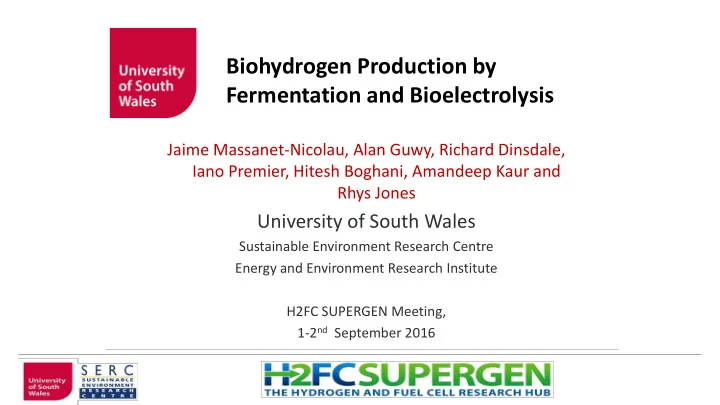

Biohydrogen Production by Fermentation and Bioelectrolysis Jaime Massanet-Nicolau, Alan Guwy, Richard Dinsdale, Iano Premier, Hitesh Boghani, Amandeep Kaur and Rhys Jones University of South Wales Sustainable Environment Research Centre Energy and Environment Research Institute H2FC SUPERGEN Meeting, 1-2 nd September 2016
Fermentative Hydrogen Production • Adaptation of anaerobic digestion • Carbohydrates are converted to hydrogen, carbon dioxide and organic acids • Current lab experiments use sucrose as a substrate in a continuously stirred bioreactor
Introduction Biomass to biomethane -mature technology: • AD is widely deployed in many countries • Germany has over 4000 AD installations • In India at least 3 million small size digesters exist. • China counts many thousand with implementation set to increase significantly. • AD industry estimated to employ ~10,000 in Germany – worth over €1billion to the German economy. – expected to rise to a turnover of €18 billion by 2030.
Limitations of Fermentative AD • Yield ( L H 2 kg -1 VS or mol H 2 mol -1 hexose ) • Residual energy remains in effluent (VFAs) • Use of complex carbohydrates • Antagonistic microbial processes • End product inhibition • Gas separation and concentration • To solve these problems an advanced and integrated approach is needed!
In Situ Recovery of Hydrogen • PEM membrane (apparatus is similar to a hydrogen fuel cell) • Very selective for hydrogen • Low energy requirements which scale with hydrogen recovered.
In Situ Recovery of Volatile Fatty acids • Electrodialysis of fermenter contents • Utilises pairs of cation and anion selective membranes • Dialysed stream returned to bioreactor • Concentrated VFAs can be used in other applications eg additional hydrogen via MEC.
Conversion of Organic Acids to Hydrogen • 2 chamber tubular system with cation exchange membrane • Anode: Carbon cloth, Volume: 1.6L • Cathode: Carbon cloth with Pt as catalyst, Volume 7L • Feed: VFAs (acetate and butyrate) • Applied Voltage: 0.85V
Overall Schematic of Fermentation System
Results – Hydrogen Recovery Massanet-nicolau, J., Jon, R., Guwy, A., Dinsdale, R., Premier, G., & Mulder, M. J. J. (2016). Maximising biohydrogen yields via continuous electrochemical hydrogen removal and carbon dioxide scrubbing. Bioresource Technology , 218 , 512 – 517.
Results – Hydrogen Recovery
Results – Organic Acid Recovery • Initial tests performed in batch on effluent from sucrose fermentation • VFA concentrations produced during fermentation could be reduced by up to two orders of magnitude within 60 minutes Jones, R. J., Massanet-Nicolau, J., Guwy, A., Premier, G. C., Dinsdale, R. M., & Reilly, M. (2015). Removal and recovery of inhibitory volatile fatty acids from mixed acid fermentations by conventional electrodialysis. Bioresource Technology , 189 , 279 – 284.
Results – Combined Acid and Hydrogen Recovery
Possible Effect Of Lowering Acetate Concentration On Homoacetogenesis
Results – Microbial Electrolysis
Summary of Findings • In situ hydrogen and carbon dioxide removal increases hydrogen yield from 0.07 to 1.79 mol H 2 /mol hexose. • Electrodialysis can increase hydrogen yields by as much as 300% but the effect is dependant on loading rates and HRT • The microbial electrolysis cell was able to convert VFA end products to additional hydrogen at the rate of 39L H 2 Kg -1 COD • These technologies can be operated together forming an integrated system, significantly increasing hydrogen yields.
Further Work • Use of more recalcitrant substrates in fermentation stage – currently underway. • Optimisation of MEC via integration with hydrogen removal stage • Scale up of experiments to pilot scale.
Recommend
More recommend